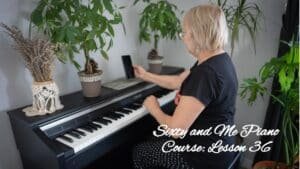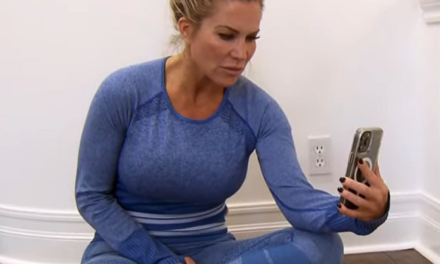
NOTE: If you are just joining us for the first time, you can find my previous Sixty and Me Free Piano Lessons on my Author pages. You can join our lessons any time and move at your own pace!
36.1 Minuet, p.89
Today we revisit the Minuet you played in Lesson 28, but this time we are adding some bass notes to the melody. One of the most difficult things for beginning piano students to learn is that the bar lines between the measures including the repeat bars :|| do not mean to stop, or pause. The bar lines simply serve to divide music into sections of 3 or 4 beats each (according to the time signature) as an organizational tool for the eye.
This is particularly important to remember when you see the repeat bars :||. In the Minuet, you play the 1st ending, then seamlessly repeat back to the beginning, without pausing. The listener shouldn’t be able to discern where the repeat sign is, because the music keeps playing at the same consistent tempo.
When you practice the Minuet on p.89, you might practice starting from the 1st ending, then repeating back to the beginning, several times, until you can achieve that seamlessly without pausing. Remember, when you are playing the Minuet for the second time, play the full first line, then play the first measure of the second line, then jump to the 2nd ending, skipping the 1st ending. (You only play the 1st ending the first time.) The bass notes in the 1st ending are a little tricky, so watch my demonstration of the Minuet in my video:
36.2 Keys, Chords and Swing! p.90
I introduce “Key Signatures” on p. 90. When you see flats or sharps between the Clef and the Time Signature, that is the Key Signature. Clementine has a B-flat in the Key Signature, which means that you will play all Bs in the song as B-flats, automatically.
In my video I speak about the fact that these flats and sharps represent the “Key” or “Scale” in which the song is written. You haven’t yet studied full scales (that comes in Upper Hands Piano, BOOK 2), but for now, remember that the F pentascale (a pentascale is the first 5 notes of a scale) you have used in Exercises #1-4 contained a B-flat. That B-flat in a key signature (usually) means that the song is in the Key or Scale of F. Clementine has a B-flat in the Key Signature, and it is indeed in the Key of F.
36.3 Oh My Darling, Clementine Demonstration, p.90
When a song has the word “Swing” over the time signature at the beginning of the piece, it means that you play the eighth notes (not the quarter notes) in a long-short lazy sounding rhythm. Clementine is played in Swing rhythm, which you learned about when you played Erie Canal (p. 71) in Lesson 23.
Clementine is presented as a “Lead Sheet” or in Fake Book form, meaning that there is no bass staff, but simply chord symbols for the left-hand to play. Notice that I play my left-hand F chord high; it is close to my right-hand melody so that I can play the middle C (in red on p.90) with my left hand.
Piano and Poetry Parties
In my video 36.2 above I discuss what my student Jackie shared at the bottom of p.90 in our Upper Hands Piano, BOOK 1. This student used to gather with friends simply for wine and cheese tastings, and they would listen to playlists she would curate as background music. When she started taking piano lessons, Jackie came up with a brilliant idea to augment the wine and cheese they enjoyed together.
She challenged her friends to each bring a poem, story, or piece of art, or to sing and/or play a song or piece to share. Her friends agreed and brought an eclectic assortment of offerings – an in-progress quilt, a watercolor painting, some photographs, a song sung with ukulele, a poem recited, a story told, a dance performed, a cake baked, etc., – and Jackie performed a piano piece she was working on.
Everyone supported each other’s creative pursuits, and they felt that they had truly elevated their group’s gatherings. They called them Piano and Poetry Parties, and they continue twice per year to this day.
You might consider doing something like this with your friends or family. Having an upcoming performance date helps motivate us to practice more than we might otherwise. Though the idea of playing for others might make you feel nervous, remember that your loved ones love you, and rather than judging you for your mistakes, they will applaud your progress.
If everyone is contributing something creative, you will all feel similarly vulnerable; do it anyway! Just keep taking deep breaths to relax your body. (This really does work!) Once you get a few of these informal performances behind you, it will start to feel less scary, and more fun.
It will feel like an accomplishment, a goal met. Spring and summer might be the best times to host a Piano and Poetry Party (or whatever you might name your creative gathering) when covid, cold and flu cases are low.
Passion Practice
- Exercise #2 (Appendix iii) in B-flat and F, with hands together.
- p.89 – Play the Minuet with hands separately and together. Watch my video 36.1 and practice playing from the 1st ending to the beginning a few times each day, until you can play this transition smoothly.
- p.90 – Watch my Clementine demonstration video, 36.3 above. Practice playing the chords left hand alone a couple times before playing with hands together. Remember the B-flats! And remember to Swing the eighth notes.
- Chord Calisthenics #4 – (Appendix viii) Play all 12 of the minor triads with hands together, starting with F minor, then B-flat minor, etc. moving backwards towards C minor. See how many minor triads you can play from memory.
Let’s Have a Conversation:
Would you consider hosting something like a Piano and Poetry Party? What might you play for your friends? What kind of foods might you serve, or would it be potluck? Do you think you would be nervous and perfectionistic, or would you be able to just do your best and have fun with your performance? Have you ever tried taking long deep breaths to calm your nerves? Have you already played the piano for loved ones? How did it feel?





